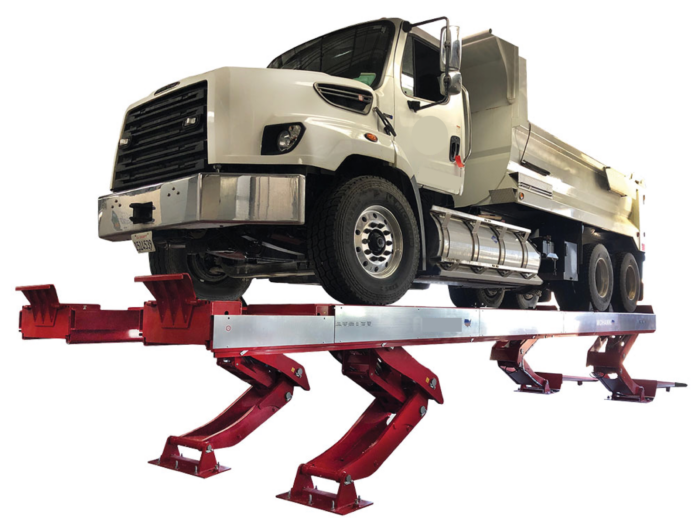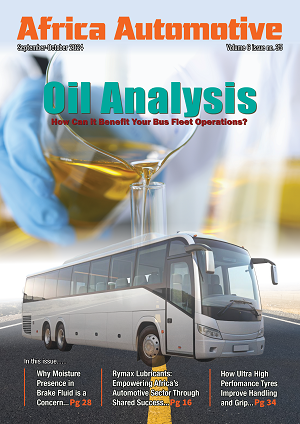Owning a garage that includes services specializing in heavy-duty truck repair or maintenance means investing in robust and reliable equipment. Among the most critical pieces of equipment, is your heavy-duty truck lifting equipment. These machines not only help you to efficiently service and maintain your customers’ trucks but also ensure the safety of your technicians. The wrong choice can lead to safety hazards, and lost productivity.
Speaking to Luuk Zonneveld – Executive Director at LiftMotive Europe, he highlights that, “When it comes to choosing the best heavy duty truck lifting equipment, garage owners should look beyond the basics and aim for innovation. Personally, I’m a huge fan of the latest breakthrough feature in advanced lifts: the Reverse Gravity Polar System (RGPS).”
Zonneveld further explains, “This revolutionary system uses magneto-gravitational inversion technology embedded in the lift pads to reverse the gravitational pull under the truck. Instead of pushing the truck up like traditional lifts, the RGPS neutralizes gravity itself, making the vehicle float effortlessly above the ground.”
He continues, “This not only reduces mechanical strain on the lift structure but also minimizes tire stress, undercarriage wear, and operator fatigue. Watching a 12-ton truck levitate with Zen-like grace is something out of science fiction, and yet, it’s here. It’s perfect for intricate underbody work, allowing 360-degree access with zero obstruction.”
Undoubtedly, with so many options available in the market, it can be overwhelming to decide which one is the best fit for your garage. Let’s discuss the top features to consider when selecting the right lifting equipment for your garage and ensure both efficiency and safety for your operation.
Types of Heavy Duty Truck Lifting Equipment
Several types of heavy-duty truck lifting equipment cater to different needs and budgets. Understanding their strengths and weaknesses is crucial for making an informed decision:
Two-Post Lifts: These are a cost-effective option, ideal for lifting individual axles or sections of a truck. They offer versatile positioning and are relatively easy to install. However, their capacity is typically lower than other options, limiting their suitability for extremely heavy trucks.
Four-Post Lifts: These provide exceptional stability and higher lifting capacities, making them ideal for larger and heavier trucks. They offer greater safety and ease of access for working underneath the vehicle. Four-post lifts occupy a larger footprint, requiring significant floor space in your garage.
“Alternatively, there are drive on lifts such as a four post runway type (available up to 120,000 lb capacity) lifts, parallelogram lifts up to 100,000 lbs. or vertical rise lifts in the drive on ramp style. All offer wheels free rolling jacks & a tire dolly with the capacity to remove dual truck tires as they are too heavy to lift for any one person,” comments Steve Perlstein – Marketing manager at Mohawk Lifts. He continues, “The four post however give the widest under vehicle access (4’) when fully raised as the other 2 platform lifts offer slightly less (possibly blocking undercarriage access).”
Scissor Lifts: These are known for their compact design and relatively low height when retracted, making them a space-saving option for garages with limited overhead clearance. However, their lifting capacity is usually lower than two-post or four-post lifts. They’re best suited for lighter trucks or specific maintenance tasks.
Wheel Lifts: These are designed for lifting individual wheels or axles, facilitating tire changes and brake repairs. While not suitable for lifting the entire truck, they are a valuable addition to any garage. They are compact and cost-effective but lack the versatility of other options.
Capacity and Lifting Height: Matching Your Needs
Before you even determine your garage precise needs. What is the heaviest truck you anticipate lifting? Consider not only the chassis weight but also the potential added weight of components, fluids, and repair equipment that might be on the truck during lifting.
Overestimating your capacity needs is always safer than underestimating; a lift that’s too small will limit your capacity and potentially damage the equipment. Your chosen heavy-duty truck lifting equipment should comfortably handle the maximum weight with significant safety margin.
“Heavier trucks need heavier lifts which brings the choice of either mobile column lifts which raise vehicles by the tires, give full undercarriage access & as the name infers, are portable. These range from 14,000 to 30,000 lbs capacity per post & generally used in sets of 4 columns (4 columns x 14,000 gives a 56,000 lb capacity),” says Perlstein.
Next, assess the required lifting height. Will you need enough clearance to work comfortably underneath the entire truck, accessing all components? Sufficient lifting height allows for thorough inspections, repairs, and maintenance without compromising your workspace or safety.
Consider the space available in your garage; you need adequate overhead clearance to accommodate the lift at its maximum height without impacting other equipment or operations.
Essential Safety Features: Prioritizing Operator and Vehicle Protection
Invest in heavy-duty truck lifting equipment that incorporates multiple safety features such as:
Automatic Safety Locks: These prevent accidental lowering or dropping of the vehicle during operation. Look for lifts with multiple locking points for enhanced stability.
Joss Chaikin – SAL Equipment Marketing Manager emphasizes, “When choosing heavy-duty truck lifting equipment, safety should be the first priority. Look for lifts with reliable automatic locking systems, pressure limiters, and reliable safety features that prevent failure under load.”
Overload Protection: This crucial feature prevents you from exceeding the lift’s rated capacity, safeguarding the equipment and preventing accidents.
Emergency Lowering Systems: In case of power failure, a manual lowering system is essential to ensure safe descent of the vehicle.
Hydraulic System: Look for a reliable hydraulic system with leak detection and protection mechanisms to prevent sudden drops or failures. Regular maintenance is crucial to extend the longevity of the hydraulic components.
Clear Load Capacity Indicators: Easily visible indicators should clearly display the weight being lifted and the lift’s maximum capacity. Emphasizing on capacity, Chaikin affirms that, “Capacity matters too. Make sure the lift exceeds your heaviest vehicle’s gross weight.”
Wheel Chocks and Restraints: Always use wheel chocks and restraints to further secure the vehicle during lifting and maintenance. These are not part of the lift itself, but are crucial safety components.
Construction and Durability: Investing in Longevity
The materials used in the construction of your heavy-duty truck lifting equipment significantly impact its lifespan and reliability. Look for lifts made from high-strength steel with robust welds. Check for certifications from reputable organizations that ensure the lift meets safety standards.
In his words, Chaikin is certain that, “Durability is non-negotiable. A solid steel build, clean welds, and protective finishes like a proffesional grade powder coating make a difference in long-term reliability, especially in harsher workshop environments.”
Additionally, according to Perlstein, “The critically most important part of buying a lift is the welding, design & materials (construction) of the lifts. Some have great prices but I’d not stand under them. Others are higher quality yet no matter the great price on the wrong piece of equipment it’s always going to remain the wrong piece of equipment.”
Adaptability and Versatility of the Equipment
You want to invest in equipment that can handle various types of trucks. Look for lifting equipment that comes with adjustable lifting arms and adapters to accommodate different truck configurations, given that, heavy-duty trucks come in various shapes and sizes, so your lifting equipment needs to be adaptable to accommodate different wheelbases, track widths, and body styles.
“Versatility is also important if you’re working on buses, trailers, or agricultural vehicles. Mobile column lifts are especially practical for this,” adds Chaikin.
Ease of use for Increase Productivity
Heavy duty truck lifting equipment should be user-friendly, with clear instructions and intuitive controls. This can help reduce training time for technicians and increase productivity.
“Ease of use is another key factor.” Says Chaikin. “Simple controls, fast lifting and lowering cycles, and minimal training requirements improve daily efficiency,” he adds.
Maintenance and Service Accessibility
Easy access to key components is essential for regular maintenance and repairs. Consider how easily you can access hydraulic lines, pumps, and other vital parts. A well-designed lift will allow for straightforward maintenance procedures, minimizing downtime and maximizing the equipment’s operational life. Choose a supplier that offers reliable parts and service support.
As Chaikin endorses, “Always consider after-sales support and parts availability. A great lift is only as good as the local support behind it. Delays in service or spares can cripple operations.”
Mobility and Space-Saving Design
If you plan to use the lifting equipment in different locations or on different trucks, look for equipment that is mobile and easy to transport. Consider equipment that has wheels or a portable design, as this can make it easier to move around the garage or to different job sites. Additionally, the equipment should also be able to be stored vertically or horizontally to save even more space.
Budget and Return on Investment
While upfront costs are a factor, consider the long-term return on investment (ROI). A high-quality, durable lift may have a higher initial cost, but its extended lifespan and reduced maintenance needs will ultimately save you money.
Factor in the cost of installation, maintenance, and any potential repairs when calculating your total investment. Choosing the right heavy-duty truck lifting equipment is a significant investment for your garage. In light of this, by carefully considering the crucial factors discussed above, you can select a system that enhances efficiency, ensures safety, and delivers a strong return on your investment for years to come.
Don’t hesitate to consider suppliers that offer installation, training and ongoing maintenance services. Remember, prioritizing safety and choosing reputable suppliers ensures your business runs smoothly and profitably.




